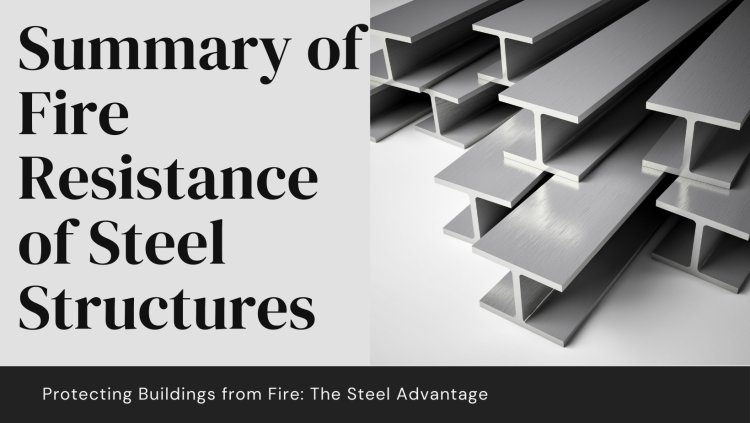Summary of Fire Resistance of Steel Structures
Discover the importance of Fire Resistance Steel in construction for enhanced safety, structural integrity, and compliance with fire safety regulations. Choose SBF RAPID TMT.

Steel is a fundamental material in modern construction, known for its strength, durability, and versatility. However, one of the critical aspects that construction professionals must consider is the fire resistance of steel structures. This blog will explore the importance of fire resistance in steel, how it is achieved, and why selecting the right type of steel, such as Fire Resistance Steel, is crucial for building safety and integrity.
Understanding Fire Resistance in Steel
Fire resistance refers to the ability of a material to withstand fire or to provide a specified level of protection against fire. For steel structures, this means maintaining their load-bearing capacity and structural integrity when exposed to high temperatures. Unlike materials that combust, steel does not burn, but it can lose strength and stiffness when exposed to elevated temperatures, potentially leading to structural failure.
The Importance of Fire Resistance Steel
Using Fire Resistance Steel in construction is crucial because it ensures that structures can withstand high temperatures for extended periods without significant loss of strength. This type of steel is engineered to resist the detrimental effects of fire, providing additional safety and reliability. Fire Resistance Steel is essential for buildings in areas prone to fire hazards, such as industrial facilities, warehouses, and high-rise buildings.
How Fire Resistance is Measured
The fire resistance of steel is measured in terms of its ability to endure high temperatures without losing its structural properties. This is typically quantified in hours, indicating how long a steel element can withstand fire exposure before failing. Fire resistance ratings are determined through standardized fire tests that simulate the conditions of a real fire, assessing the performance of steel under extreme heat.
Methods to Enhance Fire Resistance
Several methods can enhance the fire resistance of steel structures:
1. Fireproofing Coatings
Applying fireproofing coatings, such as intumescent paint, can significantly increase the fire resistance of steel. These coatings expand when exposed to high temperatures, forming an insulating layer that protects the steel from heat.
2. Encapsulation
Encapsulating steel elements in fire-resistant materials, such as concrete or gypsum, can provide additional protection against fire. This method helps to shield the steel from direct exposure to flames and heat.
3. Using Fire Resistance Steel
Opting for Fire Resistance Steel, which is specifically designed to withstand high temperatures, can inherently improve the fire resistance of a structure. This type of steel undergoes special treatments and alloying processes to enhance its performance under fire conditions.
Benefits of Fire Resistance Steel in Construction
1. Enhanced Safety
Fire Resistance Steel significantly enhances the safety of a building by ensuring that the structure remains stable and secure during a fire. This is crucial for allowing safe evacuation and providing additional time for firefighting efforts.
2. Structural Integrity
By maintaining its structural integrity at high temperatures, Fire Resistance Steel prevents the collapse of buildings, reducing the risk of catastrophic failures. This is especially important in high-rise buildings and industrial structures.
3. Cost-Effective Solution
While fireproofing coatings and encapsulation methods can be effective, they often add to the construction cost and complexity. Using Fire Resistance Steel can be a more cost-effective solution as it inherently possesses the necessary properties to withstand fire.
4. Compliance with Regulations
Many building codes and regulations require certain levels of fire resistance for steel structures. Using Fire Resistance Steel helps ensure compliance with these standards, avoiding potential legal and safety issues.
Real-World Applications of Fire Resistance Steel
1. High-Rise Buildings
In high-rise buildings, the risk of fire spread and structural collapse is a significant concern. Fire Resistance Steel provides the necessary protection to ensure that these structures can withstand fire and remain safe for occupants.
2. Industrial Facilities
Industrial facilities often contain flammable materials and processes that can increase the risk of fire. Fire Resistance Steel is essential in these environments to prevent structural failures that could lead to severe consequences.
3. Public Infrastructure
Public infrastructure, such as bridges and tunnels, requires high levels of fire resistance to ensure public safety. Using Fire Resistance Steel in these structures helps protect them from the potentially devastating effects of fire.
Conclusion
Fire resistance is a critical consideration in the construction of steel structures. By using Fire Resistance Steel, builders and engineers can ensure that their projects are not only robust and durable but also safe and compliant with fire safety regulations. This specialized steel provides an effective and cost-efficient solution to enhance the fire resistance of buildings, ensuring they can withstand high temperatures without compromising their structural integrity.
For construction projects that require the highest standards of fire safety, consider using Fire Resistance Steel from SBF RAPID TMT. Their products are engineered to provide superior fire resistance, ensuring your structures remain safe and secure even in the event of a fire.For top-quality Fire Resistance Steel that ensures the safety and durability of your construction projects, choose SBF RAPID TMT.
What's Your Reaction?










![Wireless Connectivity Software Market Size, Share | Statistics [2032]](https://handyclassified.com/uploads/images/202404/image_100x75_661f3be896033.jpg)



